
Universal Plug-and-Play (UPnP)
Universal Plug and Play Overview
Universal Plug and Play (UPnP) is a distributed, open networking standard that uses TCP/IP for simple
How do I know if I’m using UPnP?
UPnP hardware is identified as an icon in the Network Connections folder (Windows XP). Each UPnP compatible device installed on your network will appear as a separate icon. Selecting the icon of a UPnP device will allow you to access the information and properties of that device.
NAT Traversal
UPnP NAT traversal automates the process of allowing an application to operate through NAT. UPnP network devices can automatically configure network addressing, announce their presence in the network to other UPnP devices and enable exchange of simple product and service descriptions. NAT traversal allows the following:
•Dynamic port mapping
•Learning public IP addresses
•Assigning lease times to mappings
Windows Messenger is an example of an application that supports NAT traversal and UPnP.
See the Network Address Translation (NAT) chapter for further information about NAT.
Cautions with UPnP
The automated nature of NAT traversal applications in establishing their own services may present network security issues. Network information and configuration may also be obtained and modified by users in some network environments.
All
UPnP broadcasts are only allowed on the LAN.
See later sections for examples of installing UPnP in Windows XP and Windows Me as well as an example of using UPnP in Windows.
Configuring UPnP
From the Site Map in the main menu, click UPnP under Access Management to display the screen shown next.
The following table describes the labels in this screen.
LABEL | DESCRIPTION |
|
|
UPnP | Select this checkbox to activate UPnP. Be aware that anyone could use a UPnP application to open the web configuration’s login screen without |
| entering NB14WN’s IP address (although you must still enter the password to access the web configuration). |
|
|
Auto configured | Select this check box to allow |
| device. For example by using NAT traversal, UPnP applications automatically reserve a NAT forwarding port in order to communicate with another |
| UPnP enabled device; this eliminates the need to manually configure port forwarding for the UPnP enabled application. |
|
|
Apply | Click Apply to save your settings back to home screen. |
|
|
ADSL2+ Wireless N150 Modem Router User Guide | YML14WN |
36 | www.netcomm.com.au |
